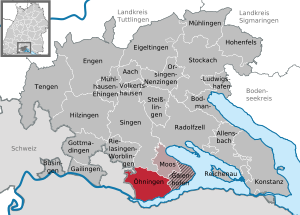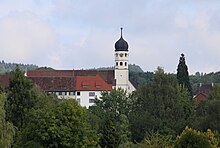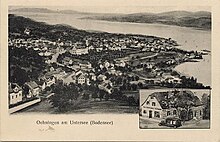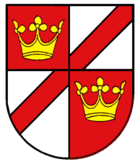Öhningen
| coat of arms | Germany map | |
|---|---|---|

|
Coordinates: 47 ° 40 ' N , 8 ° 53' E |
|
| Basic data | ||
| State : | Baden-Württemberg | |
| Administrative region : | Freiburg | |
| County : | Constancy | |
| Height : | 499 m above sea level NHN | |
| Area : | 28.2 km 2 | |
| Residents: | 3671 (December 31, 2018) | |
| Population density : | 130 inhabitants per km 2 | |
| Postal code : | 78337 | |
| Area code : | 07735 | |
| License plate : | KN | |
| Community key : | 08 3 35 061 | |
| LOCODE : | DE OHG | |
| Address of the municipal administration: |
Klosterplatz 1 78337 Öhningen |
|
| Website : | ||
| Mayor : | Andreas Schmid ( CDU ) | |
| Location of the municipality of Öhningen in the district of Konstanz | ||
The municipality of Öhningen is a state-approved resort in the district of Konstanz in Baden-Württemberg in Germany, right on the border with Switzerland .
geography
Geographical location
Öhningen is located near the Swiss border on the westernmost tip of Lake Constance , the so-called Untersee , and is the largest municipality on the Höri peninsula .
Neighboring communities
The municipality of Gaienhofen joins the municipality to the east , the municipality of Moos to the north and the Swiss town of Stein am Rhein to the west . The southern boundary of the municipality is formed by the shores of the Untersee.
Community structure
The municipality of Öhningen, with the former municipalities of rails and cheeks, includes 35 villages, hamlets, farms and houses.
 |
The municipality of Öhningen within the boundaries of 1974 included the village of Öhningen with Endorf, Ennetbruck, the hamlets of Kattenhorn (with Kattenhorn Castle ) and Stiegen, the farms Aspenhof, Bruderhof, Elmenhof, Kreuzhof, Litzelhauserhöfe, Riedernhöfe and Stuttgarterhof and the houses in Oberstaad and Waldheim. In the municipality of 1974 were the desert areas of Kressenberg or Özenberg and Sitternhof. |
 |
The former community track the village tracks and the farms on the mountain, Brandhof, Bühlarz, Fehlhaldenhof, Ferdinand Lust included (height), Längehof, Oberbühlhof, Oberschrotzburg, Sandhof, Schorenhof, stuccoes, Unterbühlhof, Unterschrotzburg (Buchhaldenhof) and Wieshof. The defunct Schrotzburg castle and an abandoned castle at Unterbühl were in the area of the former municipality of Schienen . |
 |
The former municipality of Wangen included the village of Wangen-Dorf, Marbach Castle and Homestead, the Langenmoos, Ober-Salenhof and Unter-Salenhof farms and the Blanhof, Wangen-West and Ziegelhof houses. The desert areas Dürrenmühle, Hofen and Wibelspüren are located in the area of the former municipality of Wangen. |
history
Kaspar Löhle from Wangen found stone axes and stumps on the lakeshore near Wangen in 1811, which were only associated with the remains of human settlements later (from 1854/56). Modern pile-dwelling archaeologists found other cultural layers, including a. the Horgen culture (3300-3000 BC) and the cord ceramic culture ( 2700-2600 BC), and from the early to late Bronze Age (1600-800 BC). The finds are exhibited in the Fischerhaus Museum in Wangen. Öhningen was first mentioned in 788 in a deed of donation from the St. Gallen monastery together with Weiterdingen . The donor Iringus transferred everything he owned in Öhningen to the St. Gallen monastery "for the sake of his soul".
In honor of the saints Peter, Paul and Hippolytus , Count Kuno von Öhningen founded a Benedictine monastery in Öhningen in 965 and gave him a considerable amount of basic equipment with properties in many places in Hegau . The document from 965, with which Emperor Otto I supposedly confirmed the Öhningen Foundation, is probably in all parts a forgery from the 12th century. Öhningen is one of the many early monasteries on the Rhine and Untersee that made this region a center of spiritual, but also artistic, economic and political life at that time. The provost's office was occupied by Augustinian canons in 1378 , who remained in Öhningen until the abolition of the monastery in 1805. Oberstaad Castle was first documented in 1395 . A mayor appeared in a document in 1766. In 1497, a local parliament met for the first time, each with twelve people from the rulers and the citizens of Öhningen. Later (1802) the community owned a town hall in Endorf, which also contained the school. In the 17th century, Jewish families settled in Wangen, from which a Jewish community developed, which increased to 233 members (1865) and had its own cemetery and synagogue . The latter was destroyed by the National Socialists during the pogrom night in 1938 . In 1940 seven Jews from Wangen were deported, only two of whom could be liberated.
The current town hall was built in 1650 as the seat of the episcopal superior bailiff in Öhningen. The Racial Treaty, which established the center of the lake as the border with Switzerland, was concluded in 1684. Most of the Schiener Berg became a landscape protection area in 1954. The Evangelical Hearing Parish was founded after there had been Protestant believers in the village since 1818. The guest room in Schönblick used to be used as a church service room. The Protestant Petruskirche in Kattenhorn was consecrated in 1959. Today's municipality of Öhningen was created on January 1, 1975 through the merger of the formerly independent communities of Öhningen and Wangen and the incorporation of rails. The municipal area covers 2818 hectares. The first meeting of the new municipal council took place on January 2nd. On April 7th, Hermann Lohner was appointed mayor of the new community. The renovated parish church of Öhningen was inaugurated. In the fall, the rails kindergarten was opened. The new municipality received a new municipality coat of arms in 1976, which consists of a combination of the coats of arms of the previous municipalities. In 1984 the first contact with the French town of Mérinchal began, from which a lively partnership developed. The brotherhood chapel in Öhningen has been renovated. The center of Öhningen was placed under monument protection in 1999. In 2004 the renovated town hall in Öhningen was inaugurated.
Religions
The majority of the residents are Roman Catholic , as evidenced by four churches in the parish. Probably also because of Öhningen's membership in the Constance monastery , the Reformation long passed the community by; The Protestant Petruskirche in Kattenhorn was not consecrated until 1959 . It has three remarkable windows designed by the artist Otto Dix , who lived in the neighboring village of Hemmenhofen . The community in Gaienhofen is responsible for the spiritual care of the Protestant Christians , the New Apostolic believers are looked after from Gailingen on the Upper Rhine . The Jewish community, which emerged in the 17th century, and the synagogue were destroyed during the Nazi era.
politics
Administrative association
The community is a member of the Höri community administration association based in Gaienhofen .
Municipal council
The municipal council consists of the elected voluntary councilors and the mayor as chairman. The mayor is entitled to vote in the municipal council.
The local election on May 26, 2019 in Öhningen led to the following official final result. The turnout was 68.2% (2014: 59.2%; 2009: 59.4%).
| Party / list | % | Seats | 2014 result | Result 2009 |
|---|---|---|---|---|
| CDU | 34.3% | 5 seats | 37.0%, 5 seats | 31.8%, 5 seats |
| Öhningen-Rail-Wangen network | 23.9% | 3 seats | 24.4%, 3 seats | 17.1%, 2 seats |
| Free Citizens List (FBL) | 19.4% | 3 seats | 21.2%, 3 seats | 23.2%, 3 seats |
| Open Citizens Forum (OBF) | 22.4% | 3 seats | 17.6%, 3 seats | 28.0%, 4 seats |
mayor
Mayor of the municipality of Öhningen is Andreas Schmid ( CDU ).
coat of arms
The old coat of arms of Öhningen is a quartered shield, in the first and fourth fields in red a golden crown with three prongs with leaves, in the second and third fields in silver a red oblique left bar.
The new coat of arms of the municipality of Öhningen is divided and split above; Up front it shows to twelve places a red crown with three prongs with leaves, back in red a golden star, down from silver and blue in gold geschacht .
Community partnerships
- Mérinchal (France)
- Sornzig ( Sornzig-Ablaß since 1994 , incorporated into Mügeln in Saxony in 2011 ).
Culture and sights
museum

The Fischerhaus Museum in the district of Wangen and a replica pile dwelling house provide an overview of the UNESCO World Heritage Site of prehistoric pile dwellings around the Alps and fossil finds in Öhningen.
The discovery of a petrified giant salamander Andrias Scheuchzeri from Öhningen went down in the history of paleontology because the Zurich city doctor Johann Jakob Scheuchzer misinterpreted it in 1726 as the skeletal remains of a person who drowned in the biblical flood.
Verrucano boulder natural monument
The boulder made of Verrucano rock found in the Gewann Sittern near Linsenbühlhof near Öhningen in 2002 belonged to the north face of the African Gondwana crust plate ten to a hundred million years ago, before it moved to Central Grisons during the continental drift and through the Rhine glacier 25,000 years ago during the ice age was shipped to Öhningen.
Former Oehningen Monastery
The church of the Augustinian canons' monastery and the building of the monastery essentially date from the 17th century.
Genesiuskirche rails
Early Romanesque church of the former rail monastery
Economy and Infrastructure
education
Öhningen has a primary and secondary school with a technical secondary school . There are pure elementary schools in each of tracks and cheeks. There are also two communal and one Roman Catholic kindergarten .
traffic
Both the Lake Constance circular route and the Lake Constance cycle route pass Öhningen.
Personalities
Honorary citizen
- Hermann Lohner (1928–1998), Mayor of Öhningen; On the occasion of his retirement in 1988, Lohner was awarded the Freiherr-vom-Stein-Medal by the Baden-Wuerttemberg Municipal Association; in 1989 he was made an honorary citizen; the Hermann-Lohner-Weg was named after him.
- Herbert Quandt (1910–1982), entrepreneur
- Eberhard Ratzel (1934–2011), Deputy Mayor
- Otto Wiedenmaier, Mayor of Rails
Sons and daughters of the church
- Carl Diez (1877–1969), politician (ZENTRUM, BCSV), MdR, member of the Baden State Presidium
- Jacob Picard (1883–1967), poet of German rural Jewry
- Hermann Bosch (1891–1916), national soccer player
- Klaus Klemm (* 1942), educational scientist
- Florian Schneider-Esleben (1947–2020), musician, member of the band Organization (1969), then Kraftwerk (1970–2009)
literature
- Herbert Berner (Ed.): Öhningen 1988. Contributions to the history of Öhningen, rails and cheeks. Singing 1988, ISBN 3-921413-85-0 .
- Peter Greis: From the old days. Öhningen, rails, cheeks. Konstanz 1991, ISBN 3-87685-133-5 .
- Gerfried Schellberger: The pilgrimage place of rails in the mirror of history - 750–2000. Small story of a village, embedded in the great history of its country. 2 volumes, Öhningen 2006–2008, ISBN 3-00-017825-2 .
- Mathias Köhler: Catholic parish and pilgrimage church of St. Genesius in rails. , Lindenberg 2005, ISBN 3-89870-214-6 .
Web links
Individual evidence
- ↑ State Statistical Office Baden-Württemberg - Population by nationality and gender on December 31, 2018 (CSV file) ( help on this ).
- ^ The state of Baden-Württemberg. Official description by district and municipality. Volume VI: Freiburg administrative region. Kohlhammer, Stuttgart 1982, pp. 742-746, ISBN 3-17-007174-2 .
- ^ Community of Öhningen - Öhningen. Retrieved February 16, 2019 .
- ^ Andreas Bihrer: Monasteries in Baden-Württemberg
- ^ Federal Statistical Office (ed.): Historical municipality directory for the Federal Republic of Germany. Name, border and key number changes in municipalities, counties and administrative districts from May 27, 1970 to December 31, 1982 . W. Kohlhammer, Stuttgart / Mainz 1983, ISBN 3-17-003263-1 , p. 520 .
- ↑ Source: Konstanz district archive
- ^ Result of the City Council 2019 Öhningen. Preliminary final result. In: oehningen.de. Retrieved August 21, 2019 .
- ↑ Höri week. (PDF) Volume 19; No. 22 May 31, 2019, p. 15 , archived from the original on July 29, 2019 ; accessed on August 21, 2019 .
- ^ City of Mügeln: Sornzig
- ^ Museum Fischerhaus: The pile dwellings of Wangen and the petrifications of the Öhninger layers
- ↑ a b Georg Exner: Ratzel becomes an honorary citizen , Südkurier from September 30, 2004 (accessed November 30, 2013)







